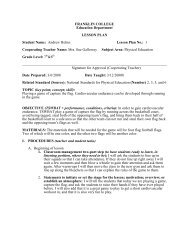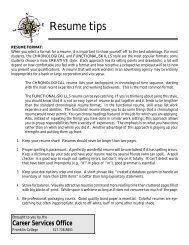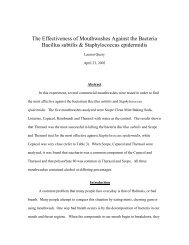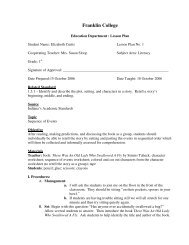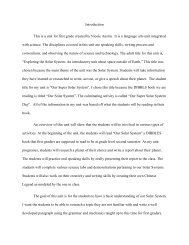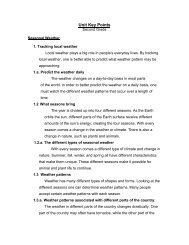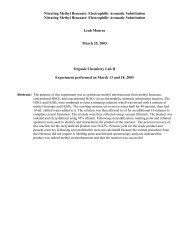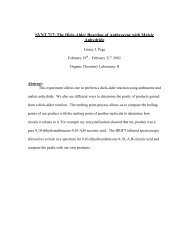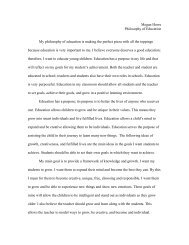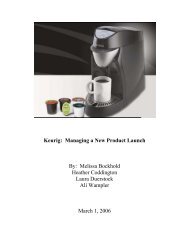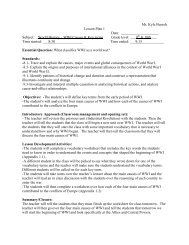Melissa Bockhold Heather Coddington - Franklin College
Melissa Bockhold Heather Coddington - Franklin College
Melissa Bockhold Heather Coddington - Franklin College
You also want an ePaper? Increase the reach of your titles
YUMPU automatically turns print PDFs into web optimized ePapers that Google loves.
Seagate Technology Buyout<br />
By: <strong>Melissa</strong> <strong>Bockhold</strong><br />
<strong>Heather</strong> <strong>Coddington</strong><br />
Laura Duerstock<br />
Ali Wampler<br />
March 22, 2006
TABLE OF CONTENTS<br />
I. Introduction……………………………………………………………………3<br />
II. Assumptions…………………………………………………………………...4<br />
III. History………………………………………………………………………....4<br />
IV. SWOT Analysis……………………………………………………………….6<br />
V. The Disk Drive Industry………………………………………………………7<br />
A. Market Share………………….…………………………………………...7<br />
B. Competition………………………………………………………………..8<br />
C. Marketing and Sales Structure………………………………………….....9<br />
D. Products…………………………………………………………………..10<br />
VI. Seagate Background………………………………………………………….11<br />
VII. The Buyout…………………………………………………………………. 14<br />
VIII. Problematic Issues and Recommendations…..………………………………19<br />
A. Seagate’s Low Stock Price……………………………………………….19<br />
B. Buyout Financing & Capital Structure......................................................20<br />
C. Valuation of Seagate……………………………………………………..26<br />
i. Company, Competition, & Industry Information……………...26<br />
ii. Analysis of Historical Financial Statements…………………...36<br />
iii. Projected Financial Statements………………………………...37<br />
IX.<br />
D. Needs and Concerns of VERITAS………………..……………………..41<br />
Conclusion…………………………………………………………………...42<br />
X. Silver Lake Partners Interview……..………………………………………...44<br />
XI. Seagate Technology Interview……………………………………………….46<br />
XII. Works Cited………………………………………………………………….48<br />
2
I. INTRODUCTION<br />
In 1999, Seagate Technology, Inc., decided that in order to increase their market<br />
value, they needed to make some big changes. Due to their undervalued stock price,<br />
Seagate decided to undergo a leveraged buyout (LBO) with Silver Lake Partners L.P.<br />
During this time, four main concerns arose among the parties involved:<br />
• How can Seagate address the company’s low stock price?<br />
• How should the buyout be financed? What should the capital structure look like?<br />
• How much should investors pay to acquire Seagate’s disk drive operations?<br />
• How can Seagate address VERITAS Software Corporation’s needs and concerns?<br />
After analyzing the case and talking to executives at Silver Lake and Seagate, we<br />
think that Seagate’s low stock price is best addressed by a leveraged buyout with a new<br />
capital structure composed of 45% equity and 55% debt. Furthermore, we have found<br />
that the company is worth approximately $2 billion in the buyout. Finally, VERITAS<br />
should agree to participate in the deal because they will also win by retiring a portion of<br />
their stock.<br />
conclusions.<br />
The subsequent sections of this report will further explain how we arrived at these<br />
3
II. ASSUMPTIONS<br />
In analyzing the capital structure, the value of the company, and stock price of Seagate<br />
Technology, we are operating under the following assumptions:<br />
• Corporate tax rate of 34%<br />
• Market risk premium of 9% (based on 75-year historic average)<br />
• Capital expenditures from Projected Operating Performance of Seagate Disk<br />
Drive Business are Seagate’s projected net working capital<br />
• Seagate had no NCS before the leveraged buyout.<br />
III. HISTORY<br />
Brief History of Seagate Technology LLC and the Technology<br />
Industry<br />
1970s Buyouts are born.<br />
1979 Seagate is founded by a group of five technology entrepreneurs and executives.<br />
1980s Significant growth in use of buyouts occurs.<br />
Mid-1980s<br />
Slowdown in PC sales occurs. Computer manufacturers cut back significantly<br />
on disk drive purchases.<br />
Late 1980s<br />
The use of buyouts reaches its peak. The average transaction carries a debt-tototal<br />
capitalization ratio of 92%.<br />
Leveraged Buyout (LBO) firms show a tendency to avoid the technology<br />
1980s-Early 1990s industry due to rapid growth, short product life cycles, uncertain demand, and a<br />
typical lack of tangible assets.<br />
The luster of buyouts fades in the wake of the failure of several 1980s LBOs.<br />
Early 1990s Slowdown in PC sales occurs. Computer manufacturers cut back significantly<br />
on disk drive purchases.<br />
1992-1993<br />
Seagate is the ONLY independent disk drive manufacturer to remain<br />
profitable.<br />
Mid-1990s<br />
LBOs resurface, but they are much smaller and are much more conservatively<br />
structured.<br />
1996-Early 1997<br />
Seagate experiences a downturn, along with the rest of the industry, and<br />
launches a broad restructuring effort.<br />
Late 1990s<br />
Disk drive industry benefits from increasing worldwide demand for electronic<br />
data storage, but fierce price competition emerges.<br />
4
1997<br />
1997-1998<br />
July 1998<br />
May 1999<br />
June 1999<br />
Late 1999<br />
October 1999<br />
Early November<br />
1999<br />
1999<br />
1999<br />
January 2000<br />
March 2000<br />
2000<br />
Total number of disk drive units sold continues to increase, but overall<br />
revenues begin to decline due to a dramatic drop in prices. New areas to gain<br />
revenue are explored to make up for the lag of revenue growth behind unit<br />
growth.<br />
Seagate closes or sells selected manufacturing operations in Ireland, Scotland,<br />
Malaysia, Mexico, and the Philippines.<br />
Approximately 80% of Seagate’s 111,000 employees are located in Asia.<br />
Luczo becomes COO of Seagate.<br />
Slowdown in PC sales occurs yet again. Computer manufacturers cut back<br />
significantly on disk drive purchases.<br />
Alan Shugart, Seagate’s co-founder and CEO, is ousted by the board and<br />
replaced by Stephen Luczo.<br />
Seagate sells its Network & Storage Management Group (NSMG) to<br />
VERITAS Software for 155 million shares of VERITAS’s stock, thus<br />
becoming its largest shareholder, with an ownership stake of more than 40%.<br />
At the end of the fiscal year, 39% of Seagate’s sales come from desktop drives,<br />
51% from enterprise systems, and tape drives and software contribute the<br />
remaining 10%.<br />
As a result of abandoning the mobile disk drive segment, discontinuing several<br />
product lines, and making cuts of expenditures on new production facilities, the<br />
company’s employee headcount decreases by over 20%.<br />
Luczo is authorized by Seagate’s board of directors to seek advice from<br />
Morgan Stanley to increase Seagate’s stock price.<br />
Luczo meets with representatives of Silver Lake Partners L.P. to discuss a<br />
major restructuring of Seagate. Morgan Stanley proposes a leveraged buyout<br />
of its disk drive operations, followed by the tax-free acquisition of its<br />
remaining assets by VERITAS Software Corporation.<br />
Seagate is the leader in number of units shipped in Enterprise (41.0%) and<br />
Desktop (21.1%) segments. Seagate leads the worldwide market with a 21.1%<br />
share.<br />
Again, Seagate is the ONLY independent disk drive manufacturer to remain<br />
profitable.<br />
Seagate enters the storage networking segment with the acquisition of privately<br />
held XIOtech Cory, a provider of SAN technology.<br />
Negotiations among Silver Lake, Seagate, VERITAS, and their advisors<br />
continue.<br />
Seagate is the leader in the worldwide disk drive industry, with total annual<br />
revenues of nearly $7 billion and a market share of 21%.<br />
(Andrade)<br />
5
IV. SWOT ANALYSIS OF SEAGATE<br />
Strengths<br />
• Hard disk drives are the most common media for storing electronic information.<br />
• Largest market share in the worldwide disk drive market<br />
• Leader in the worldwide industry by 2000<br />
• Designs, manufactures, and markets a broad product line<br />
• Multiple distribution channels<br />
• Only independent disk drive manufacturer to be fully vertically integrated<br />
• Products for both high-end and low-end markets<br />
Weaknesses<br />
• VERITAS stock owned by Seagate is worth more than Seagate’s entire market<br />
capitalization<br />
• Core disk drive operations are not receiving full value in stock market<br />
• Overall revenue decline due to decreasing prices since 1997<br />
• Higher research and development costs and capital expenditures than competition<br />
Opportunities<br />
due to vertical integration<br />
• Increasing demand for larger and more efficient data access and storage devices<br />
• Rapidly expanding demand for desktop disk drives due to consumer electronics<br />
Threats<br />
appliances requiring storage of large amounts of data<br />
• Volatile financial performance in industry<br />
6
B. Competition<br />
Competition is the most important factor to consider in this industry. Due to the<br />
relatively even market share distribution, each company has several viable competitors;<br />
there are many manufacturers, but a limited number of customers exist. This amplifies<br />
the competition in the disk drive manufacturing market. High supply relative to the<br />
demand for disk drives creates fierce competition among suppliers (Andrade 3). This is<br />
reflected in the product prices and revenues of disk drive manufacturers.<br />
000s of units<br />
300<br />
250<br />
200<br />
150<br />
100<br />
50<br />
0<br />
Worldwide Hard Disk Drive Industry Historical Performance & Projections (1999-2003E)<br />
1991 1992 1993 1994 1995 1996 1997<br />
Years<br />
1998 1999 2000E 2001E 2002E 2003E<br />
Total Sales<br />
8
millions of $<br />
35000<br />
30000<br />
25000<br />
20000<br />
15000<br />
10000<br />
5000<br />
0<br />
Worldwide Hard Disk Drive Industry Historical Performance & Projections (1991-2003E)<br />
1991 1992 1993 1994 1995 1996 1997<br />
Years<br />
1998 1999 2000E 2001E 2002E 2003E<br />
Total Revenue<br />
In the graphs above, we can see that total unit sales have steadily grown between<br />
1991 and 1999 due to an increase in worldwide demand for disk drive storage. The<br />
demand, however, is not growing fast enough to keep prices stable. Looking at the graph<br />
of total revenues, it is clear that revenues have not followed the same steady, upward<br />
trend. Prices have been driven down so far that, even with stable growth in unit sales,<br />
revenues are unsteady and often decline from year to year. Pricing competition among<br />
disk drive manufacturers has created this trend, and industry experts expect it to continue<br />
(Andrade 3).<br />
C. Marketing and Sales Structure<br />
Competition among disk drive manufacturers is also prevalent in the industry<br />
because suppliers sell to the limited number of customers. Each product cycle, lasting six<br />
9
to twelve months, is a new opportunity for suppliers to gain sales relationships with new<br />
customers and to continue selling to past customers. Typically, each customer uses only<br />
a few disk drive suppliers at any given time. At the beginning of the new product cycle,<br />
customers pre-select the suppliers they will use for the upcoming year. Customers<br />
execute this process based on pre-announced performance and reliability requirements<br />
and the availability of new products at the time of pre-selection. If a manufacturer does<br />
not have new products to test or good performance to offer customers at this critical time,<br />
they could potentially lose up to a year’s sales. Perhaps an even more serious<br />
repercussion is the potential for damaging sales relationships with customers (Andrade<br />
3).<br />
D. Products<br />
Disk drive manufacturers have explored new products and avenues to remedy the<br />
lag in revenue growth, mentioned in the above section on competition in the disk drive<br />
industry.<br />
One area explored was storage networking. With the presence and prolific use of<br />
the internet, email, and video and audio applications, options for larger and more efficient<br />
data storage are increasingly necessary and in demand. Storage Area Networks (SAN)<br />
and Network Attached Storage (NAS) are sophisticated options that manufacturers can<br />
differentiate in the market and offer to the consumer (Andrade 3).<br />
The other option is to enter the consumer electronics market. As consumer<br />
products evolve, more and more data storage is necessary. Video data storage devices<br />
(i.e. TiVo ® ), music storage devices (i.e. iPod ® ), video games consoles (i.e. Xbox ® ), and<br />
personal computers are examples of products for this market. While the year 2000<br />
10
projected sales of $0.5 billion for this market are small in comparison to the $26 billion<br />
projection for the mainstream market, quick and steady growth is expected over the next<br />
three years (Andrade 4).<br />
Although these options are extremely attractive, possible problems lie within<br />
competition, the most critical issue for the disk drive manufacturing industry. Bottom<br />
lines will be affected, but this is difficult to measure. First, in the case of storage<br />
networking, disk drive manufacturers would be competing against well-established<br />
companies such as IBM and Dell. Predicting the success of smaller companies would<br />
prove difficult. Second, because the consumer electronics industry is not immune to the<br />
same competition that exists in the traditional disk drive business, there would be no way<br />
to gauge the possibility of fierce competition and the dropping prices that would result<br />
(Andrade 4).<br />
VI. SEAGATE TECHNOLOGY<br />
Unlike its competitors in this industry, Seagate practices vertical integration.<br />
Seagate believes that vertical integration has several advantages. First, they have the<br />
ability to control critical enabling technologies. By doing this, Seagate can eliminate the<br />
risk of suppliers cutting down on research and development during slow economic times.<br />
A second benefit to Seagate’s vertical integration is their control over the manufacturing<br />
process, which allows them to increase production in a shorter amount of time if an<br />
unexpected surge in demand occurs. Before Seagate took over manufacturing control,<br />
increasing production took 12 weeks and levels could only be increased up to 80% of<br />
target output. The final benefit of vertical integration is that Seagate can maintain lower<br />
11
inventories of disk drive components since they do not have to worry about suppliers<br />
meeting their demands (Andrade 4).<br />
Although Seagate’s reasoning behind vertical integration is sound, their ideas are<br />
not supported by many. Vertical integration tends to have substantially higher fixed<br />
costs. While these high costs can be sustained, it can hurt a company in an economic<br />
downturn. Most companies do not control manufacturing. Instead, they outsource the<br />
production of computer hardware to specialized contract equipment manufacturers<br />
(Andrade 5). The case states, and we agree, that by outsourcing the manufacturing<br />
process to a few businesses, those entities could obtain economies of scale, resulting in a<br />
lower cost for the hard disk drive industry. Since pricing is a major factor in competition<br />
in the disk drive industry, being able to produce at a lower cost could give a company an<br />
advantage over the competition.<br />
Determining whether or not vertical integration is optimal is a difficult decision.<br />
There are many factors to consider in the disk drive industry. We believe that each<br />
company needs to look at what is most important to them. Do they wish to have the<br />
absolute lowest costs, or do they prefer to have control over their product in order to<br />
maintain high quality standards and appease their buyers? Control is Seagate’s primary<br />
concern. While vertical integration may be frowned upon by many industry analysts,<br />
Seagate was the only company that maintained profitability during the economic<br />
downturns of 1992 and 1999 (Andrade 5). However, since pricing is such an important<br />
factor in this industry saturated by competition, incurring high fixed costs could paralyze<br />
Seagate if other companies are able to undersell them.<br />
12
In 2000, Seagate was leading the worldwide disk drive market with a 21% share<br />
of the total market. Taking all of this into consideration, we conclude that Seagate’s<br />
vertical integration is not a bad strategy. Seagate’s success shows that controlling both<br />
supply and research and development trumps the importance of pricing competitively in<br />
the long run, since Seagate has proven to have the ability to ride economic downturns.<br />
The disk drive industry is described as extremely volatile. During slowdowns,<br />
companies can incur losses due to excess capacity and inventory. When a company has<br />
excess inventory, their main objective is sell at a discount and cut their losses. Seagate<br />
found a way to weather most of these downturns. The secret to their success lies in their<br />
product mix. Seagate sells its disk drives not only to the high-end market, but to the low-<br />
end market as well. Because of this mix, Seagate has earned a reputation of an efficient,<br />
low-cost producer. Selling to the lower markets allows Seagate to achieve economies of<br />
scale which has led to lower costs.<br />
The only downturn Seagate has not able to fend off occurred in 1996 and early<br />
1997. In response, the company decided to restructure. Seagate closed manufacturing<br />
operations, left the mobile disk drive segment, stopped several product lines, and cut back<br />
spending on new production facilities. The other major change from the 1996-97<br />
downturn was the removal and replacement of Alan Shugart, Seagate’s co-founder and<br />
CEO, with Stephen Luczo (Andrade 5).<br />
Luczo decided to diversify away from traditional segments and to move into<br />
faster-growing, higher-margin businesses. He also wanted to increase investment in<br />
technology. In order to achieve these expansions, Seagate needed to make significant<br />
capital investments (Andrade 6). Luczo decided the best way to accomplish these goals<br />
13
was to turn the company private since disk drive producers had a hard time obtaining<br />
capital for long-term projects. He turned to Silver Lake Partners L.P., a private equity<br />
firm, for help (Andrade 1).<br />
VII. THE BUYOUT<br />
In May of 1999, Seagate sold one of its companies, the Network & Storage<br />
Management Group (NSMG), to VERITAS in return for 155 million shares of VERITAS<br />
stock. The transaction made Seagate VERITAS’s largest stockholder, creating an<br />
ownership stake of over 40% (Andrade 6).<br />
When a few problems regarding stock prices arose, concerned shareholders were<br />
not far behind. Following the transaction, the market was failing to recognize the value<br />
of Seagate’s stake in VERITAS, as evident from a 200% increase in VERITAS stock<br />
versus only a 25% increase in Seagate’s stock. The board felt that the market was<br />
incredibly under pricing Seagate’s stock. After two failed attempts to increase Seagate’s<br />
stock price and unlock its value from VERITAS, the company turned to Morgan Stanley<br />
for help. In early November of 1999, Morgan Stanley arranged a meeting between<br />
Seagate executives and representatives of Silver Lake Partners (Andrade 6).<br />
After several months of discussion, Silver Lake delivered a proposal and potential<br />
solution to Seagate’s problem. This proposal involved a complicated two-step<br />
transaction. The first step, illustrated below, would involve Seagate selling off its disk<br />
drive business, including about $765 million in cash, to a newly-formed company<br />
controlled by Silver Lake. The purchase would be financed through a LBO in which<br />
Silver Lake and other private equity investors would provide a portion of the selling price<br />
through equity, and the rest would be financed through debt (Andrade 7).<br />
14
Buyout<br />
Investors<br />
The second step, illustrated on the following page, would involve merging the<br />
remaining Seagate shell corporation with VERITAS through a tax-free stock swap. Each<br />
share of Seagate stock outstanding would be exchanged for a combination of cash and<br />
VERITAS shares. VERITAS would then acquire the Seagate shell corporation and its<br />
128 million shares of VERITAS stock. In exchange, Seagate would receive 109 million<br />
new VERITAS shares. No corporate or personal tax liability would be created by the<br />
transaction as long as the merger qualified as “reorganization” under Section 368(a) of<br />
the Internal Revenue Code (Andrade 7).<br />
STEP ONE:<br />
Seagate sells all operating assets to group of investors.<br />
I. Cash<br />
(Buyout purchase price)<br />
• Operating Assets<br />
• $765 Million Cash<br />
SEAGATE<br />
TECHNOLOGY<br />
15
STEP TWO:<br />
Seagate exchanges existing equity stake in VERITAS for new VERITAS shares.<br />
The remaining Seagate assets are distributed to shareholders.<br />
SEAGATE<br />
SHAREHOLDERS<br />
• 109 Million VERITAS Shares<br />
• Cash Proceeds of Buyout<br />
• Cash in Excess of $765 Million<br />
SEAGATE<br />
TECHNOLOGY<br />
• 109 Million VERITAS Shares • 128 Million VERITAS Shares<br />
VERITAS<br />
SOFTWARE<br />
16
A leveraged buyout is a concept that arose during the 1970s, and it became a very<br />
popular finance tool in the high-yield bond market of the 1980s (Andrade 8). By<br />
definition a LBO is the “acquisition of a company or division of a company with a<br />
substantial portion of borrowed funds” (Note). While every LBO is unique with respect<br />
to its specific capital structure, all LBOs use financial leverage to complete the<br />
acquisition of a target company. The equity that LBO firms invest in an acquisition<br />
comes from a fund of committed capital that has been raised from institutional investors<br />
like private equity firms, insurance companies, college endowments, and individual<br />
qualified investors.<br />
Buyout funds are typically structured as limited partnerships. The firm’s<br />
principles (management) act as the general partner, and the investors in the fund act as<br />
limited partners. The general partner makes all investment decisions regarding the fund,<br />
while the limited partners are responsible for making sure the funds are available when<br />
they are needed or requested. These funds have a few standard provisions that include a<br />
minimum commitment, an investment or commitment period, and term and<br />
diversification. Also, the LBO firm will generate revenues in one of three ways: carried<br />
interest, management fees, or co-investment (Note). Below are examples of typical<br />
capital structures for LBO transactions from 1980-1999.<br />
17
100%<br />
90%<br />
80%<br />
70%<br />
60%<br />
50%<br />
40%<br />
30%<br />
20%<br />
10%<br />
0%<br />
23%<br />
16%<br />
Capitalization Structure for LBO Transactions (1980-1999)<br />
61% 63%<br />
29%<br />
8%<br />
60%<br />
40%<br />
1 2 3 4 5<br />
Equity Subordinated Debt Senior Debt<br />
The first bar is a recreation of a typical capital structure of the early 1980s. The<br />
second and third bars are recreations of typical structures of the late 1980s and the market<br />
recession in the first two years of the 1990s. The last two bars are examples of common<br />
capital structures resulting from leveraged buyouts in the rebirth (1992-1993) of the<br />
market and the bull market (1994-1998) (Andrade 17).<br />
There are many advantages to using leveraged debt in acquisitions. One of the<br />
biggest advantages is the tax shield that arises from making interest payments. It is much<br />
more appealing for companies to create a tax deduction opportunity than to create a tax<br />
payment obligation like the ones that occur with dividend payments.<br />
Another reason leveraged transactions can be advantageous is that often large<br />
principle and interest payments will compel management to improve performance<br />
50%<br />
20%<br />
30%<br />
45%<br />
35%<br />
20%<br />
18
operating efficiency. Therefore, the debt acts as a disciplinary tool that forces<br />
management to focus on specific initiatives that might otherwise be postponed or rejected<br />
(Note). A LBO is secured by the assets of the acquired business, just like a home<br />
mortgage is secured by the value of the house being purchased. The bought-out business<br />
(Seagate) continues to generate cash flows that are used to service debt incurred in its<br />
buyout. In a successful LBO, equity holders (Silver Lake) tend to receive very high<br />
returns because the shareholders are locked into a fixed return while the equity holders<br />
receive all the benefits from any capital gains. “A LBO fund typically tries to realize a<br />
return on a LBO within three to five years” (Note). At the end of this period, the equity<br />
firm will exit. There are three typical exit strategies of a LBO. These strategies include<br />
an outright sale of the company, a public offering, or a recapitalization (Note).<br />
VIII. PROBLEMATIC ISSUES AND RECOMMENDATIONS<br />
A. Seagate’s Low Stock Price<br />
To address a low stock price, a company can do several things. First, they can<br />
repurchase their own shares in the open market. This would decrease supply, increase<br />
demand, and potentially result in a higher price per share. Second, a company can sell<br />
the shares they hold in other companies. This will lower their amount of investments by<br />
reducing holdings in other companies. Third, a company can liquidate its assets and<br />
remove itself from the market entirely. Finally, a buyout or merger can be performed.<br />
When the issues with Seagate’s low stock price arose in 1999, senior management<br />
tried several options to remedy the problem. Initially, Seagate’s management sold<br />
VERITAS shares they held and then bought back some of their own stock in the open<br />
market. They felt that decreasing the amount of outstanding Seagate shares and untying<br />
19
the value seen in its VERITAS holdings would result in a higher share price. Both of<br />
these actions, however, failed in increasing the incredibly low stock price, so Seagate’s<br />
management had to look for other options.<br />
The company could have cut its losses by liquidating its assets and completely<br />
getting out of the market. The problem with these options lies in the fact that huge tax<br />
liabilities would be incurred for the company and its shareholders, and the entity would<br />
be permanently terminated. The only other option for Seagate was a buyout or merger.<br />
The plan they formulated and executed, a leveraged buyout, was an alternative to<br />
liquidation. First, the creation of corporate or personal tax liabilities would be avoided.<br />
Also, the company would be able to continue operations. As a result of the leveraged<br />
buyout, Seagate will be a privately held company, and they will no longer trade stock in<br />
today’s market. After the equity investors exit, Seagate will be able to re-enter the<br />
market and issue their stock to be valued based on the company’s performance alone.<br />
Management hopes that this action will result in the fair valuation of their stock once<br />
public status is reinstated (Austin).<br />
We agree with the Seagate senior management’s decision to go ahead with the<br />
two-stage leveraged buyout. By avoiding heavy taxation, everyone wins. This was the<br />
only option for Seagate to use if they were to ensure both the happiness of shareholders<br />
and the future of the Seagate name and company.<br />
B. Buyout Financing & Capital Structure<br />
It is apparent from the above section that, over time, significant changes have<br />
occurred in the capital structure of companies post-buyout. The downturn of the business<br />
cycle, the near collapse of the junk bond market and diminished structural advantages<br />
20
have all contributed to these changes since 1988 (Note). In the mid-1990s when LBOs<br />
started to resurface, they were much smaller than those of the 1980s, and the capital<br />
structures became much more conservative, as evident from the final three bars in the<br />
chart on page 18 (Andrade 8).<br />
Because LBOs must support extremely high amounts of debt, firms typically<br />
target companies that operate in mature industries, generate stable and predicable cash<br />
flows, and have a considerable amount of tangible assets that can be used as collateral<br />
(Andrade 8). As of June 1999, Seagate has a fairly large amount of tangible assets,<br />
$7,072 million, however, it is their unpredictable yearly cash flows that cause much<br />
concern for investors to invest in their disk drive operations (Andrade 5). Firms also look<br />
for a clean balance sheet with little debt, a strong, defensible market position, limited<br />
working capital requirements, minimal future capital requirements, strong management, a<br />
viable exit strategy and the potential for expense deduction (Note). Seagate seems to be<br />
unappealing in the fact that they have a significant amount of debt compared to their<br />
competition ($704 million versus $110 - $236 million). But they do possess a strong,<br />
defensible market position as the leader in the worldwide disk drive industry.<br />
The disk drive industry is not an easy place for LBOs for other reasons, as well.<br />
Pricing competition, as we have stated, is intense among competitors, and product life<br />
cycles are typically less than six months in length. Manufacturing costs and investments<br />
are also high in this industry because companies must be able to meet the demands of<br />
their customers very quickly for fear of losing key business relationships. Also, because<br />
of the “technological sophistication” of the disk drives, a huge investment into a<br />
company’s research and development (R&D) is required annually (Andrade 9).<br />
21
For all the reasons listed above, Seagate appears to be operating in a very risky<br />
market, yet the company also possesses a few attributes that give it the potential to do<br />
well as a LBO. As we have discussed earlier, Seagate’s vertical integration gives the<br />
company a strong competitive advantage while avoiding the costs of supply chain<br />
problems. The high R&D and capital expenditure requirements also provide a barrier of<br />
entry into the market (Andrade 9).<br />
Because changes have occurred in how LBOs are structurally financed, returns<br />
have become much more difficult to generate through leverage. Today, LBO firms are<br />
looking to build value in acquired companies by improving profitability and pursuing<br />
growth (Note). Silver Lake has great confidence in Seagate’s current management, and<br />
they believe the company’s vertical integration cuts costs that improve the company’s<br />
bottom line. Seagate, therefore, appears to be an investment that will be able to generate<br />
significant returns for their investors. Also, many analysts expect that Seagate will re-<br />
enter the mobile disk drive segment, which is likely to be an attractive area for future<br />
company growth (Andrade 6).<br />
While generating returns is important for private equity companies, a company’s<br />
investment grade rating is very important to the LBO. If Seagate is able to maintain their<br />
current rating of BBB, investors and analysts believe that the company will have greater<br />
access to future financing. Since Seagate’s annual cash flows are somewhat<br />
unpredictable, a buyout, like the one proposed by Silver Lake, will require the company<br />
to have a higher level of equity and lower debt leverage in order for Seagate to retain<br />
their current investment grade rating (Andrade 10). According to the table below, the<br />
22
equity required in the LBO will have to be greater than 30.4% due to the above-average<br />
risk level of the industry in which the company operates.<br />
S&P Key Industrial Financial Ratios by Long-Term Debt Rating<br />
Three-Year Medians—1997 to 1999<br />
AAA AA A BBB BB B CCC<br />
EBIT Interest Coverage 17.5x 10.8x 6.8x 3.9x 2.3x 1.0x 0.2x<br />
Total Debt as % of Market Cap. 3.7% 9.2% 16.4% 30.4% 47.5% 59.3% 74.3%<br />
The increase in the equity requirements for a leveraged buyout of a company such<br />
as Seagate will change the proportions of the company’s capital structure after the<br />
buyout. Less leveraging will have to be done in this particular case, than in past buyouts<br />
because there is a much larger risk of debt failure.<br />
Based on Seagate and Silver Lake’s objective to maintain their current investment<br />
grade rating, BBB, we feel that their capital structure after the LBO should be composed<br />
of 45% equity, 50% senior debt, and 5% subordinate debt. The equity portion of the<br />
capital structure is composed of two parts. The first part is the equity, provided by the<br />
private equity firm, Silver Lake, and its partners like Texas Pacific Group (Snow). We<br />
feel these groups should provide approximately 89% of the total equity for the project, or<br />
40% of the capital structure. The other 11% of the total equity should be provided by<br />
Seagate’s top six managers including Luczo and Charles Pope, Seagate’s current CFO.<br />
One of the stipulations of the deal specifies that these six managers must continue in their<br />
current roles, and they must also “convert a portion of their Seagate equity into new<br />
equity and deferred compensation of the company that would operate the disk drive<br />
business” (Andrade 8). This stipulation exists for two reasons. First, Silver Lake has a<br />
23
large amount of confidence in Seagate’s current management. Second, by having<br />
management invest alongside the private equity company, Silver Lake is ensuring an<br />
alignment between management and shareholder interests. Typically in situations such as<br />
this, the private equity firm will own between 70-90% of the common equity of the<br />
bought-out company (Note). Thus, Silver Lake’s 89% ownership of common equity is<br />
right on target.<br />
The senior debt will be financed by large financial institutions such as commercial<br />
banks. Debt provided from these institutions is typically comprised of two components:<br />
a revolving credit facility and term debt. Senior debt carries seniority or preference over<br />
the other types of debt used in a LBO. These lenders have the most senior claim against<br />
the cash flows and assets of a business, so principle and interest payments to this group<br />
take precedence over other types of debt (Note). In Seagate’s particular case, we feel that<br />
approximately 50% of the company’s new capital structure should be composed of senior<br />
debt.<br />
Subordinate debt, or junior debt as it is sometimes called, is the middle section of<br />
the capital structure, and it generally fills the gap between the senior debt and equity in a<br />
transaction. This type of debt “can take the form of notes from the private placement<br />
market or high-yield bonds from the public markets, depending on the size and<br />
attractiveness of the deal” (Note). Since this type of debt has claim on a company’s cash<br />
flows and assets only after the senior debt has been dealt with, junior lenders’ low<br />
priority and high risk is compensated with higher interest rates. In Seagate’s case, we<br />
feel that this type of debt should account for 5% of their total capital structure.<br />
24
after the LBO.<br />
120%<br />
100%<br />
80%<br />
60%<br />
40%<br />
20%<br />
0%<br />
The graph below shows our recommendation for Seagate’s new capital structure<br />
Proposed Capitalization Structure<br />
50%<br />
5%<br />
5%<br />
40%<br />
Suez Acquisition Company<br />
Silver Lake Equity Seagate Mgmt Equity Subordinate Debt Senior Debt<br />
We believe an equity allocation greater than 45% will deter Silver Lake and other<br />
private equity firms from investing in Seagate because of the high levels of equity<br />
investments required and the company’s unpredictable cash flows. An equity level below<br />
45% is too risky if the company faces financial problems in the future because they may<br />
have difficulty trying to pay off the large amounts of leveraged debt. Leveraging of any<br />
kind can be a fantastic financial tool, but if Seagate’s cash flows are down in one or<br />
multiple years, the leveraged debt would be detrimental to the company. Also because of<br />
the changes in LBOs since the late 1980s, senior lenders have become increasingly wary<br />
of highly-leveraged transactions. This is another reason that we feel the new entity’s<br />
25
capital structure should have a higher-than-average amount of equity. We do not feel that<br />
senior debt should exceed 91% of the total leveraged debt used, and because of the high<br />
interests rates that can reduce a leveraged firm’s ability to weather downturns in the<br />
business cycle, we feel that 5% is the maximum amount that the company should use in<br />
subordinate debt.<br />
C. Valuation of Seagate<br />
There are three key considerations that must be included in any company valuation.<br />
These include company, competitor, and industry information; analysis of historical<br />
financial statements; and projected financial statements going out three to five years<br />
(Company Worth). When determining the value of Seagate’s disk drive business, we<br />
considered all the above.<br />
i. Company, Competitor and Industry Information<br />
Seagate holds a 21.1% market share in the worldwide disk drive industry as of<br />
1999. They are dominating in almost all sectors, evident from a 41.0% share in the<br />
enterprise market where the company experiences above-average gross margins of 20-<br />
25%, and a 21.1% share in the desktop market where the company rakes in 10-15% gross<br />
margins. The storage networking market and consumer electronics market are areas the<br />
industry feels will grow in the near future.<br />
Looking at the following sales growth and total revenue growth tables we can see<br />
where the disk drive industry has been and where it is probably headed.<br />
26
Worldwide Hard Disk Drive Industry Historical Performance & Projections (1991-2003E)<br />
1992 1993 1994 1995 1996 1997<br />
% Change in Total Sales 16 34.9 33.2 30.4 18.7 21<br />
% Change in Total<br />
Revenue<br />
7.8 -17.1 5.7 0.1 20 -0.9<br />
1998 1999 2000E 2001E 2002E 2003E<br />
% Change in Total Sales 11.1 15.5 13.2 13.1 12.1 12.6<br />
% Change in Total<br />
Revenue<br />
-6.8 -0.8 5.4 6.6 7.2 7.4<br />
When looking at the sales growth of the worldwide hard disk drive industry, we<br />
can see that the industry experienced very high growth between 1993 and 1997. As the<br />
market matured, the growth decreased drastically from 21% in 1997 to 11.1% in 1998<br />
and 15.5% in 1999. Industry analysts have predicted that the market will continue to<br />
experience a modest amount of growth in 2000 through 2003 primarily because of the<br />
almost certain increases in hard drive demand in storage networking and the consumer<br />
electronics markets (Andrade 3-4).<br />
The revenue growth in the worldwide hard disk drive market is much more<br />
volatile and less predictable. While sales for the entire industry grew rapidly from 1993-<br />
1997, the revenue growth ranges from a disappointing -17.1% to a very promising 20.0%.<br />
Therefore, revenue growth does not seem to be a reliable indicator of market<br />
performance.<br />
It is vitally important to know where a company stands when it comes to liquidity.<br />
In a situation like the one Seagate is in, it would be very helpful to know how much<br />
liquidity Seagate has. In order to get a better understanding of their situation, we<br />
calculated their financial ratios. The fundamental analysis was done using Seagate,<br />
Quantum HDD, Western Digital and Maxtor’s 1999 financial ratios (Exhibit A). The<br />
first ratio we looked at was the Current Ratio. This financial tool is used to determine<br />
27
how capable a company is to pay back their short-term liabilities by using their short-<br />
term assets. The higher this ratio is, the more able a company is to pay off these<br />
obligations. This ratio also gives us an idea of how efficient a company is at turning their<br />
products into cash. From our numbers in 1999, the Current Ratio for Seagate was 4.12<br />
when compared to its competitors Quantum HDD, Western Digital, Maxtor. Quantum<br />
HDD was the next highest with 3.11. It is easy to see that Seagate leads this category<br />
and is able to turn their assets into liquidity faster than the competition.<br />
The next ratio we looked at was the Quick Ratio. Like the Current Ratio, this<br />
financial tool also tells us about a company’s short-term liquidity. However, this ratio is<br />
more conservative than the Current Ratio because it only takes into account the<br />
company’s most liquid assets. Like the Current Ratio, the higher the result, the more<br />
capable the company is to cover all of their debts quickly. Our analysis shows that, once<br />
again, Seagate is the highest with a Quick Ratio of 3.48, while Quantum is second with<br />
only 2.67.<br />
The Cash Ratio is another liquidity ratio that can be used to evaluate a company’s<br />
short term ability to pay off their current liabilities. This ratio is even more conservative<br />
than the other two because the only asset it takes into consideration is cash. As expected<br />
from the previous ratios, Seagate is once again the highest with 2.27, while Quantum is at<br />
1.53. The other two competitors are below one, which means that they would not be able<br />
to cover all of their current liabilities with just their cash.<br />
NWC to Total Assets is another liquidity ratio that shows us how much short term<br />
liquidity a company has in relation to its total assets. In our case, Seagate has a ratio of<br />
25%. The company with the highest percentage is Quantum at 48%, and the lowest is<br />
28
Western Digital at only 7%. With this ratio, a low value indicates a low level of liquidity.<br />
From this, we see that Seagate has a sufficient amount of short term liquidity compared to<br />
its competition.<br />
Interval Measure shows how long a company could survive if the cash flows<br />
stopped. Our numbers show that Seagate would be able to remain in business for about<br />
204 days, which is the highest of the four companies. Western Digital would exit the<br />
quickest with a life span of only about 92 days.<br />
The Total Debt Ratio shows how much debt a company has compared to its<br />
assets. A company that has a Debt Ratio of more than one has more debt than assets. In<br />
contrast, a company with a ratio less than one has more assets than debt. According to<br />
our calculations, the only company that has more debt than assets is Western Digital.<br />
The company with the lowest Debt Ratio is Quantum at 0.46 and Seagate at a close<br />
second with 0.50.<br />
Debt-Equity Ratio shows what portion of the company’s debt and equity is used<br />
to finance its assets. A company with a high Debt-Equity Ratio usually has aggressively<br />
used its debt to finance its growth. Seagate’s Debt-Equity Ratio is 0.1976. While this<br />
shows that Seagate has used some debt to finance its assets, they have not used a<br />
significant amount when compared to Maxtor’s Debt-Equity Ratio of 0.8876.<br />
The Equity Multiplier displays a company’s total assets per dollar of<br />
shareholders’ equity. In other words, it shows how much in assets an investor's dollar is<br />
worth. This ratio is a commonly used tool of financial leverage. From our calculations,<br />
we found that Maxtor has the highest Equity Multiplier at 5.11, while Seagate’s is at<br />
29
1.98. Although, Seagate is much lower than Maxtor, they are still above the other major<br />
competitors.<br />
The Times Interest Earned (TIE) Ratio is used to determine a company’s ability to<br />
meet its debt obligations. A high TIE could indicate that a company is using too much of<br />
their earnings to pay off debt. This would not allow the company to use those earnings to<br />
invest in new projects and other means that would benefit the company and its<br />
shareholders. Our analysis shows that Seagate has the highest TIE Ratio; this means that<br />
compared to its competitors, they are using more earnings to pay off debt. Yet, this ratio,<br />
like all ratios, is extremely relative since Seagate has much more debt than these four<br />
competitors, and the company also has much higher sales revenue, total assets, and<br />
market share than Quantum, Western Digital, and Maxtor.<br />
Cash Coverage Ratio is a basic measure of a company’s ability to generate cash<br />
from operations, and it is often used to measure the cash flow available to cover debt<br />
obligations. Seagate, as well as Quantum, has a cash coverage ratio of 32.33. The lowest<br />
company is Western Digital with 6.21. In theory, Seagate and Quantum can generate<br />
enough cash flow from operations to cover their financial obligations about 32.33 times<br />
each.<br />
Inventory Turnover Ratio is measure of how many times a company’s inventory<br />
is sold and replenished in a given time period. A high Inventory Turnover Ratio indicates<br />
that a company has either strong sales or ineffective buying as compared to a low ratio<br />
that shows weak sales or effective buying. The ratio does not reveal much unless it is<br />
compared to the competition. Seagate has the lowest Inventory Turnover, 11.47,<br />
compared to its competitors. Quantum has the highest at 22.35. So, from these numbers,<br />
30
the ratio shows that Quantum turns their inventory over almost twice as often as Seagate.<br />
This could imply that Seagate is either being very effective with their buying, or they are<br />
showing weak sales.<br />
Days’ Sales in Inventory shows how long it takes a company to turn raw materials<br />
into sales. Seagate has the longest period with 31.36 days, and Quantum has the lowest<br />
with just 16.33 days. This ratio could indicate that Seagate needs to reduce the amount of<br />
time it takes to turn their raw materials into sales. More importantly, because Seagate is<br />
vertically integrated, they should have a lower Inventory Turnover and Days’ Sales in<br />
Inventory.<br />
The Receivables Turnover is used to determine how effective a company is at<br />
collecting debt and extending credit. A low ratio would essentially imply that the<br />
company is inefficient in their collection of debt. A high ratio could show that a<br />
company is efficient in debt collection or that they operate on a cash basis. Seagate has a<br />
ratio of 7.8. The lowest is Maxtor at 7.57, and the highest is Western Digital at 10.14.<br />
From these ratios, it appears that the industry is relatively consistent in their debt<br />
collection abilities.<br />
Days’ Sales in Receivables is a measure of how many days it takes a company to<br />
collect on their credit sales. According to our numbers, it takes Seagate 46 days to collect<br />
on their credit sales. Comparing this to the competitors, we can see that the company<br />
with the quickest collection time is Western Digital with a collection period of 36 days.<br />
The longest is Maxtor with 48.18 days. While Seagate’s 46-day collection period seems<br />
long, it is still comparable to the competition.<br />
31
The next ratio we calculated was Net Working Capital Turnover. This ratio tells<br />
us how much work we are getting out of our net working capital. A higher ratio is<br />
desired because it means the company is getting more out of every dollar of net working<br />
capital. Seagate’s ratio is 3.84, the lowest of all competitors. The highest ratio is<br />
Western Digital, which turned over net working capital 38.43 times in 1999. This<br />
discrepancy between Western Digital and Seagate is another relative issue. Western<br />
Digital has been performing relatively poorly in our fundamental analysis of Seagate and<br />
their competitors, so why do they have such an appealing NWC turnover? The answer is<br />
simple. Seagate has $1,773 million in NWC in 1999, Western Digital had only $72<br />
million, and Seagate’s 1999 sales were 2.5 times greater than Western Digital’s.<br />
Fixed Asset Turnover is a measure of sales a company generates for every one<br />
dollar in fixed assets. Seagate turns over its fixed assets 4.03 times, so, they generate<br />
$4.03 in sales for every dollar of fixed assets. Maxtor is the highest in this category,<br />
generating about $22.31 for every dollar of fixed assets.<br />
Total Asset Turnover is the same idea as the Fixed Asset Turnover; it takes into<br />
account total assets not just fixed assets. Our ratios show that for every dollar of total<br />
assets, Seagate generates $0.96. The highest company is once again Maxtor, with $2.79<br />
in sales for every dollar of total assets. Because Seagate is vertically integrated, they<br />
have higher levels of fixed assets then their competition. These higher levels will cause<br />
their Fixed and Total Asset Turnovers to be lower.<br />
The Profit Margin is the first of three ratios we examined to measure how<br />
efficiently a company uses its assets and manages its operations. Specifically, the Profit<br />
Margin tells us how much profit is generated for every dollar of sales. In most cases, a<br />
32
higher Profit Margin is more desirable. Seagate’s Profit Margin, the highest in the group,<br />
is 17%, meaning that they generate about $0.17 profit on every dollar of sales. Western<br />
Digital is the lowest this time with a Profit Margin of -18%. So, in theory, they are losing<br />
$0.18 on every dollar of sales.<br />
The Return on Assets (ROA) is a measure of profit per dollar of the company’s<br />
assets. In 1999, Seagate had a 16.63% return per dollar of assets, the highest among<br />
competitors. The lowest ROA was Western Digital with -48%. A higher ROA is more<br />
desirable because it means that the company is making more per dollar of assets.<br />
A company’s Return on Equity (ROE) is similar to the ROA, except it is the profit<br />
per dollar of the company’s equity. In 1999, Seagate’s ROE was 33%. The lowest was<br />
Quantum with -19%. Since Western Digital’s net income and shareholder equity were<br />
both negative in 1999, we did not calculate this ratio for them.<br />
The Earnings per Share (EPS) Ratio is a measure of how much profit is accrued<br />
by the shareholders for each share of stock. Seagate’s EPS was $5.17, the highest, while<br />
Western Digital had the lowest at -$3.82.<br />
The last ratio we looked at was the Price/Earnings (P/E) Ratio. This ratio tells us<br />
how much a share is selling for compared to its earnings. Seagate’s P/E is 12.41, which<br />
is to say that shares are selling at 12.41 times earnings. Maxtor is the highest with shares<br />
going for 42.45 times earnings, and Quantum has the lowest with -4.79 times earnings.<br />
When looking at how Seagate is fairing against their competition, we also looked<br />
at market share and the historical operating performance and capitalization ratios for<br />
Seagate and the U.S. disk drive industry from 1981 to 1999 (Andrade 12). The table<br />
below shows the averages for each.<br />
33
Seagate<br />
Averages (1981-<br />
1999)<br />
Disk Drive Industry<br />
Median Averages (1981-<br />
1999)<br />
EBITDA as % of Sales 13.03% 6.04%<br />
EBIT as % of Sales 8.41% 2.21%<br />
Debt/Book Assets 23.95% 12.63%<br />
Debt/Market Assets 12.22% 6.53%<br />
(Debt-Cash)/Book Assets -5.95% -6.74%<br />
(Debt-Cash)/Market Assets -3.89% -3.42%<br />
EBITDA Interest Coverage 22.49 4.49<br />
EBIT Interest Coverage 16.33 1.39<br />
EBITDA can be used to analyze and compare profitability between companies<br />
and industries because it eliminates the effects of financing and accounting decisions.<br />
EBITDA is a good metric to evaluate profitability but not cash flow. In the table above,<br />
we have averaged Seagate’s EBITDA as a percentage of their annual sales from 1981 to<br />
1999. When compared to the disk drive industry median averages, we can see that<br />
Seagate is much more profitable than the industry as a whole.<br />
EBIT is another indicator of a company’s profitability. EBIT is used much more<br />
commonly than EBITDA because it nulls the effects of different capital structures and tax<br />
rates used by different companies. By eliminating these two items, the figure focuses on<br />
the company’s ability to profit. In our table, we can see that, over the past 20 years,<br />
Seagate has had a much higher average EBIT as a percentage of their annual sales than<br />
the disk drive industry as a whole.<br />
Seagate’s Debt/Book Asset and Debt/Market Asset Ratios are much larger than<br />
the industry on average. This could mean that Seagate has significantly more debt than<br />
the average company in the disk drive industry. From 1997 to 1999, the company<br />
averaged $704 million in debt. Three companies with significant market share in the disk<br />
drive industry and major competitors to Seagate (Quantum HDD, Western Digital, and<br />
34
Maxtor) all averaged $112 million, $354.33 million, and $350.67 million in debt,<br />
respectively. These companies also have far less assets than Seagate, $7,072 million in<br />
1999 versus $863 million to $1,470 million for the competitors.<br />
While a large amount of debt is fairly undesirable in a LBO, we feel that because<br />
of Seagate’s high revenues and strong market share, this is not a huge concern for the<br />
company or potential investors when determining the value of Seagate. On the other<br />
hand, because Seagate does have debt, this means that the company has an obligation to<br />
make interest payments on this debt. The EBITDA Interest Coverage Ratio is the<br />
number of times a company is able to cover their interest obligations with the money left<br />
over from revenues after expenses (excluding tax, interest, and depreciation and<br />
amortization) have been taken out. Seagate is able to cover their interest obligations for<br />
one year 22.49 times, while the industry, on average, is only able to do so 4.49 times per<br />
year. This calculation appears to be very volatile, however. In 1997, the ratio was at<br />
43.66 times per year, and, in 1998, it dropped down to 8.84 times per year. In 1999, it<br />
jumped back up to 10.25. This volatility is due to the nature of the disk drive industry.<br />
As we have stated multiple times, cash flows and revenues are very unpredictable in this<br />
industry because of fierce competition and short product life cycles.<br />
By comparing Seagate to the disk drive industry medians, we can see that the<br />
company has been, on average, outperforming the market for the last 20 years. Also,<br />
from the analysis of Seagate’s and their top competitors’ key financial ratios, we can see<br />
that Seagate again is outperforming their competition on almost every level. These facts<br />
will carry a significant amount of weight in the valuation of the company.<br />
35
ii. Analysis of Historical Financial Statements<br />
We discussed some of Seagate’s major financial ratios in 1999 while comparing<br />
the company to their competition, but it is also very important to look at the historical<br />
statements and ratios to determine where the company has been. These ratios can be<br />
found in Exhibit A.<br />
Profitability ratios are some of the most important ratios to look at when<br />
evaluating a company’s historical performance. These ratios include the Profit Margin,<br />
Return on Assets (ROA), Return on Equity (ROE).<br />
Seagate’s Profit Margins for the past three years (1997-1999) have been 7%, -8%,<br />
and 17%. These margins re-emphasize that this industry experiences a lot of volatility<br />
from year to year in cash flows. In 1998, Seagate’s sales alone dropped $2,121 million,<br />
and net income dropped from $658 million to -$530 million. This explains why the<br />
company’s Profit Margin dropped so drastically in a 12-month period (Andrade 13).<br />
The ROA for Seagate varied from 10% in 1997 to -9% in 1998 to 17% in 1999.<br />
Again, volatility seems to be a commonality. As stated in our discussion of Profit<br />
Margin, the negative net income in 1998 forced ROA to drop dramatically. Fortunately<br />
for Seagate, their $1,706 million increase in net income in 1999 sparked a jump in ROA<br />
to a more respectable 17% (Andrade 13).<br />
ROE was 19% in 1997, -18% in 1998, and 33% in 1999. Again, 1998 is<br />
portrayed to be a very poor year for the company. Instead of making money, investors<br />
lost $0.18 on every dollar of equity in the company. However, in 1999, again because of<br />
positive net income, investors gained $0.33 on every dollar of equity.<br />
36
These three ratios seem to reveal that when business is good, Seagate is great, but<br />
when business bad, Seagate also suffers. Liquidity ratios are much more favorable for<br />
the company. These ratios, as we stated earlier, show how quickly Seagate can turn<br />
assets into cash to cover their debt obligations. Seagate’s liquidity values (or short-term<br />
solvency measures) have been very strong for the company from 1997-1999. The<br />
liquidation value of the company, which is the money left over when all assets are sold<br />
and all debt is paid off, is approximately $6,368 million. 1 A company’s Book Value is its<br />
assets less its liabilities. In 1999, the Book Value of Seagate was $5,654 million. 2<br />
The long-term solvency ratios, like Total Debt and Debt-Equity, are important in<br />
the valuation of Seagate because high debt relative to the company’s equity would make<br />
the company less appealing to private equity firms like Silver Lake. According to<br />
Charles Pope, Executive Vice President and Chief Financial Officer of Seagate, the<br />
company wanted to ensure they had no net debt prior to the buyout. Net debt is defined<br />
as interest-bearing debt less cash (and equivalents). Seagate’s interest-bearing debt in<br />
1999 was $704 million, and their cash and cash equivalents were equal to $1,623 million.<br />
Therefore, the company had no net debt prior to the buyout. This makes the company<br />
much more appealing to investors because Seagate has the ability to quickly meet their<br />
short- and long-term debt obligations.<br />
iii. Projected Financial Statements<br />
While industry information and historical analysis of financial statements are<br />
important when valuing a company, the most important factor to consider is the future.<br />
How will Seagate perform after the buyout? What type of growth will the company<br />
1<br />
Liquidation Value: Total assets – short term debt – long term debt = $7,072 - $1 - $703 = $6,368<br />
2<br />
Book Value: Total assets – accts. payable – short term debt – long term debt = $7.072 - $1 - $703 - $714<br />
= $5,654<br />
37
experience? What will their earnings be? What value will the company bring to its new<br />
investors? All of these questions and more must be answered before any group will make<br />
an investment. According to Alan Austin, Silver Lake’s Managing Director and Chief<br />
Operating Officer, “The fundamental metric of valuing a company is their cash flows”.<br />
Using the projected operating performance for Seagate below, we figured their cash<br />
flows after the buyout from 2000 to 2006 (Exhibit B).<br />
Projected Operationg Performance of Seagate Disk Drive Business<br />
Year Ending June 30,<br />
2000 2001 2002 2003 2004 2005 2006<br />
Base Case ($ millions)<br />
Revenues $6,619 $7,417 $8,564 $9,504 $10,416 $11,359 $12,350<br />
COGS 5,355 6,008 6,868 7,461 8,104 8,735 9,324<br />
Gross Margin 1,264 1,409 1,696 2,043 2,312 2,624 3,026<br />
EBITDA 141 189 316 449 499 614 724<br />
Depreciation 625 626 642 666 708 726 729<br />
Capital Expenditures 627 690 720 795 700 725 750<br />
Upside Case ($ millions)<br />
Revenues $6,619 $8,185 $10,146 $11,283 $12,626 $13,961 $15,404<br />
EBITDA 141 365 689 783 867 1,000 1,167<br />
Downside Case<br />
($ millions)<br />
Revenues $6,619 $7,393 $7,797 $8,310 $8,801 $9,269 $9,759<br />
EBITDA 141 189 322 363 378 403 407<br />
When calculating Seagate’s cash flows for the base, best, and worse case<br />
scenarios, interest was not included because it is not relevant to forecasting. Seagate will<br />
be borrowing more than in the past, and this borrowed amount has not yet been<br />
determined, thus it will play no role in the determination of Seagate’s value (Austin).<br />
Examining EBITDA is a starting point in the valuation process when looking into the<br />
company’s future. EBITDA is preferred over EBITA or EBIT because depreciation is<br />
not factored into this figure. We do not want to consider depreciation in our valuation of<br />
Seagate because depreciation is a past expense, and what was spent in Seagate’s past is<br />
38
irrelevant to their value to Silver Lake. Seagate’s projected EBITDA in the base case is<br />
averaged to be $1,093 million, the best case average is approximately $1,391 million, and<br />
the worst case average is about $989 million. While EBITDA gives us a good idea of<br />
what the value of the Seagate might be, we feel that these figures are too low.<br />
EBITDA can be used as a starting point, but total cash flows are most important<br />
to potential investors because cash flows can provide insight into the investors’ future<br />
returns. The cash flows for the base case, best case, and worst case of our sensitivity<br />
analysis can be seen in Exhibit B. We averaged these cash flows from 2000 to 2006.<br />
The base case average is approximately $1,097 million, the best case is approximately<br />
$1,293 million, and the worst case is $1,028 million. We feel that these numbers better<br />
quantify the value of Seagate.<br />
As we know, Silver Lake will also receive $765 million in cash with their<br />
purchase of Seagate’s disk drive business. With this cash figure added to the above cash<br />
flow averages, the base case becomes $1,862 million, the best case becomes $2,058<br />
million, and the worst case becomes $1,793 million. Because of Seagate’s large market<br />
share in the worldwide disk drive industry, their strong results from the fundamental<br />
analysis, their lack of net debt, their strong current management, and the potential growth<br />
in the market through storage networking and consumer electronics, we believe Seagate<br />
is worth approximately $2 billion.<br />
This figure should be approved by both parties for many reasons. First of all,<br />
Seagate should like this price because it is almost exactly what their cash flows plus the<br />
$765 million in cash are estimated to be in the best case of our sensitivity analysis. Silver<br />
39
Lake and other potential investors should jump on this price because it is less than one<br />
third of what Seagate’s projected sales will be in 2000.<br />
Using the capital structure suggested in section VIII-A, the purchase price of $2<br />
billion dollars would be divided among participants as follows:<br />
Participant $$$ Provided<br />
Silver Lake & Partners (40%) $800,000,000<br />
Seagate Management (5%) $100,000,000<br />
Senior Debt (50%) $1,000,0000,000<br />
Subordinate Debt (5%) $100,000,000<br />
With Silver Lake and their partners providing $800 million in equity for the<br />
buyout, we have calculated the net present value of their investment under time frames of<br />
three, four, and five years. We chose these project term lengths because a typical LBO<br />
lasts three to five years. The discount rate used for the investment was found using the<br />
Capital Asset Pricing Model (CAPM). We used the three-month T-Bill rate as our risk-<br />
free rate of return. This rate as of March 2000 was 5.88%. We assumed the market risk<br />
premium to be approximately 9% based on an average of the past 75 years (Corrado 191).<br />
The company’s beta is 1.2 (Andrade 13). Using these figures, we found the discount rate<br />
for the company to be 16.68%.<br />
R<br />
R<br />
R<br />
E<br />
E<br />
E<br />
= 0.<br />
0588 +<br />
= 0.<br />
0588 +<br />
= 0.<br />
1668<br />
1.<br />
2*<br />
0.<br />
09<br />
0.<br />
108<br />
40
Exhibit C shows the cash flows for Silver Lake and their partners over the length<br />
of their investment. The NPV calculations, as well as the IRR and Modified IRR, are all<br />
displayed below.<br />
NPV IRR Modified IRR<br />
3 years (2000-2002) $1,819,306,394 177.34% 73.26%<br />
4 years (2000-2003) $2,657,283,378 189.37% 68.23%<br />
5 years (2000-2004) $2,756,587,640 182.91% 57.25%<br />
From these figures, we can see that at an investment level of $800 million, Silver<br />
Lake and their partners are investing in a project with a very significant NPV. The<br />
modified IRRs show that as long as Silver Lake’s required return is less than 57.25%, the<br />
investment in Seagate should be accepted. The IRRs are modified to ensure the rate is<br />
conservative and eliminates the possibility for multiple IRRs in the calculation of NPV.<br />
It is very doubtful that Silver Lake would require a return anywhere close to 57%, so it<br />
seems feasible to state that the projected valuation of $2 billion, along with the<br />
recommended capital structure, fits the needs of Seagate with the profitability objectives<br />
of Silver Lake.<br />
D. Needs and Concerns of VERITAS<br />
The final question that needs to be addressed before the LBO can take place is<br />
making sure that VERITAS is in agreement and satisfied. After Seagate sells its disk-<br />
drive business to the Suez Acquisition Company, which Silver Lake created for the<br />
buyout, the only significant assets left are cash and VERITAS shares. VERITAS was the<br />
most likely merger, but it had no desire to acquire a disk drive business. VERITAS’s<br />
41
CFO Kenneth Lonchar stated, “We were interested in staying away from it [Seagate].<br />
We are building a nice software business, and we don’t want to be distracted” (Mintz).<br />
However, to complete this deal, Stephen Luczo had to have VERITAS’s participation.<br />
Luczo asked VERITAS to acquire the remainder of Seagate’s company, which included<br />
128 million shares of VERITAS stock. The next step in the merger would include<br />
VERITAS distributing shares of its stock to Seagate shareholders in a tax-free exchange<br />
(Mintz). “VERITAS would get 128.1 million of its shares by acquiring Seagate, but will<br />
give Seagate holders only 109.3 million shares” (Sloan). Since stock-for-stock swaps are<br />
not taxable, this allows Seagate to save around $5 billion in taxes. The stockholders also<br />
gain because the swap allows them to defer the taxes on the stock they received from<br />
VERITAS. So, a stock-for-stock swap is both beneficial to Seagate and its shareholders,<br />
but would VERITAS agree to this deal? We believe that VERITAS would agree to<br />
participate in the stock swap. “VERITAS retires $2 billion of stock without having to<br />
pay anything for it” (Sloan).<br />
IX. CONCLUSION<br />
We have just addressed the issues of Seagate’s low stock price, financing and<br />
capital structuring, as well as VERITAS’s needs and concerns. We have justified our<br />
decision to value Seagate at $2 billion, thoroughly explained how the buyout should be<br />
financed, and described how the new capital structure should look. We have given a<br />
convincing argument as to why a leveraged buyout was the best choice in addressing the<br />
low stock price. We have also addressed the concerns of VERITAS by offering them a<br />
position where the company can come out ahead by retiring $2 billion in stock without<br />
42
having to pay any taxes, while, at the same time, decreasing the amount of outside<br />
ownership.<br />
We feel that our recommendations regarding Seagate’s four main issues are the<br />
best options for Seagate to implement in order to maintain its position in the market and<br />
its future profitability.<br />
43
X. SILVER LAKE PARTNERS INTERVIEW<br />
Mr. Alan Austin, Managing Director and Chief Operating Officer<br />
Silver Lake Partners<br />
2725 Sand Hill Road, Suite 150<br />
Menlo Park, CA 94025<br />
Ph: 1-650-233-8149<br />
The following questions and responses collected through a phone interview with Silver<br />
Lake Partners Managing Director and Chief Operating Officer, Alan Austin at 4:00 PM<br />
Wednesday March 15, 2006.<br />
Question: How do you value a company when you are considering investing in<br />
them?<br />
Answer: The fundamental metric of valuing a company is their cash flow. You<br />
must look at EBITDA and Capital Expenditures. You want to start with<br />
Capital and take out the depreciation, interest expense, taxes and<br />
amortization.<br />
Taxes are not a factor because more than likely, they will be at a reduced<br />
rate after the restructuring. Interest expense is not relevant because you<br />
will be borrowing more than in the past. Depreciation is not factored in<br />
because these are your expenses of the past. What you spent in the past<br />
does not matter, from here on, it’s about future expenses. Finally,<br />
amortization is not relevant because it is non-cash.<br />
Other factors considered in valuing a company includes how fast they are<br />
growing and whether they are in an attractive market.<br />
Question: Why was Seagate given a $2 billion price tag?<br />
Answer: We used the same analysis as I explained in the last question. We looked<br />
at their EBITA and tried to see what the company could do to improve<br />
them and move forward. For example, they can cut their operating<br />
expenses.<br />
Question: How do you determine the target capital structure of a company you plan<br />
to invest in? Seagate?<br />
Answer: In 1999, the amount of debt available to companies was 100%. However,<br />
we had to look at what the company’s capacity to service the debt they<br />
undertook. There has to be a comfortable margin in case of a bump in the<br />
road. You also cannot leverage too much because then the company does<br />
not have the resources to implement the changes or take on investments to<br />
further their success.<br />
In Seagate’s example, they had no net debt at the time of the leverage.<br />
Net debt is defined as when your debt exceeds your short term assets.<br />
44
Question: How did Seagate differ from an average leveraged buyout at that time?<br />
Why was Silver Lake able to invest in what many perceived to be an<br />
unstable industry?<br />
Answer: There used to be a Harvard Business Case Study that talked about the disk<br />
drive industry. Their final answer was that the technological industry was<br />
dying and no one should invest in it. Obviously, they don’t have that case<br />
anymore.<br />
Silver Lake Partners formed during a time when the technology industry<br />
was in fact capable of investing in safely. However, many people thought<br />
this industry was not suitable for buyouts or investing. This industry was<br />
difficult to understand and their products life-cycles changed rapidly.<br />
Silver Lake Partners formed around the idea that these companies were in<br />
fact stable and they could be supported through investments.<br />
Seagate was an opportunity for Silver Lake to unlock the puzzle and come<br />
up with an effective financial engineering plan.<br />
The disk drive business was regarded as a commodity business that did not<br />
make much money and their prices weren’t stable, but went down every<br />
year. People didn’t understand why anyone would want to invest in a<br />
crummy market. However, Silver Lake understood that Seagate and other<br />
businesses like it did not have to be viewed as crummy, but could in fact<br />
be profitable.<br />
Question: What are the best ways to fix a low stock problem when a company feels<br />
that its stock price is being undervalued by the market?<br />
Answer: Maintaining investor relations is important as well as getting out<br />
information that your company is actually doing very well.<br />
Another possibility is to use a company’s excess cash to buy back stocks<br />
or make acquisitions to enhance the value of their company.<br />
Many companies try these above mentioned ideas first, and then turn to<br />
leveraged buyouts. Companies with low stock prices feel that they are not<br />
appreciated by the market and therefore it makes sense for them to go<br />
private. Then they can concentrate on restructuring the company in order<br />
to be more attractive to the market or to strategic buyers. Then at some<br />
date in the future, it is possible to have built your business back up to<br />
where they feel they can go public again.<br />
45
Copy of thank you note mailed to Alan Austin on 3/17/2006:<br />
Front: Inside:<br />
XI. SEAGATE TECHNOLOGY INTERVIEW<br />
Mr. Charles Pope, Executive Vice President and Chief Financial Officer<br />
Seagate Technology<br />
2725 Sand Hill Road, Suite 150<br />
Menlo Park, CA 94025<br />
Ph: 1-650-233-8149<br />
The following questions and responses collected through a phone interview with Seagate<br />
Executive Vice President and Chief Financial Officer Charles Pope at 6:00 PM<br />
Wednesday March 15, 2006.<br />
Question: How did you determine the value of your company?<br />
Answer: The market was valuing our company at $15 million. VERITAS and other<br />
companies were being valued at $22 billion. The market had too many<br />
discounts in place on our company evaluations. Some of the discounts<br />
included liquidity, market risk, and leakage.<br />
Question: How did Seagate and Silver Lake decide on the $2 billion selling price?<br />
Answer: We ended up settling for $2.05 billion dollars. It was a negotiated price.<br />
We set up a new corporation to acquire our assets and then teamed up with<br />
investors. The $2.05 billion was a purely negotiated value between<br />
Seagate’s board of directors and the team of investors.<br />
Question: How did you determine the capital structure?<br />
Answer: We understood the cyclical nature and the risks of our industry.<br />
Therefore, we knew that we needed lots of cash. Therefore, it is important<br />
to have as little debt as possible in order to whether the down cycles.<br />
46
We ended up with almost a 1-1 ratio of equity to debt. We raised $975<br />
million in debt and ended up with a little over $1 million in equity.<br />
Question: When did Silver Lake exit and Seagate go public again?<br />
Answer: We went public in 2002.<br />
Question: Was it your intent to go public again after being private for a few years?<br />
Answer: Our plan from the beginning was to remain private for only a short amount<br />
of time and then go public. We just needed to rebuild our business so that<br />
our market valuation would increase upon re-entry.<br />
Copy of thank you note mailed to Charles Pope on 3/17/2006.<br />
Front: Inside:<br />
Copy of thank you note mailed to Ms. Gray on 3/17/2006.<br />
Front: Inside:<br />
47
XII. WORKS CITED<br />
Austin, Alan. Managing Director and Chief Operating Officer. Silver Lake Partners.<br />
Phone Interview. 15, Mar. 2006.<br />
Andrade, Gregor, Stuart Gilson, Todd Pulvino. “Seagate Technology Buyout.” Harvard<br />
Business Case. 12, March 2002.<br />
Elliott, Heidi. “An Act of Privacy.” Electronic News (North America). Vol. 46 Issue 14.<br />
http://search.epnet.com/login.aspx?direct=true&db=buh&an=2993810.<br />
Fiduccia, Bill. “What’s Your Company Worth.” Entrepreneur.com. December 2001. <<br />
http://www.entrepreneur.com/article/0,4621,295301,00.html.<br />
Jordan, Bradford D., Stephen A. Ross, and Randolph W. Westerfield. Fundamentals of<br />
Corporate Finance. 6 th Ed. Boston: McGraw-Hill Irwin, 2003.<br />
“Merger-Makers Stumble in Selling New-Age Deal Formats.” Mergers & Acquisitions:<br />
The Dealmaker’s Journal. May 2000, Vol. 35 Issue 5.<br />
http://search.epnet.com/login.aspx?direct=true&db=buh&an=3285295.<br />
Mintz, S.L. “In VERITAS, a Good Price.” CFO. Jun 2000, Vol. 16 Issue 7.<br />
http://search.epnet.com/login.aspx?direct=true&db=buh&an=3184422.<br />
“Note on Leveraged Buyouts.” Tuck School of Business at Dartmouth. 30, Sept. 2003.<br />
http://mba.tuck.dartmouth.edu/pecenter/research/pdfs/LBO_Note.pdf.<br />
Pope, Charles. Executive Vice President and Chief Financial Officer. Seagate<br />
Technology. Phone Interview. 15, Mar. 2006.<br />
Seagate Technology. www.seagate.com.<br />
Silver Lake Partners. www.silverlake.com.<br />
Sloan, Allan. “A Deal With Taxing Consequences.” Newsweek. June 2000, Vol. 135<br />
Issue 23. http://search.epnet.com/login.aspx?direct=true&db=buh&an=3154156.<br />
Snow, David. “Silver Lake Leads $2B Seagate Buyout.” Buyouts. April 2000, Vol. 13<br />
Issue 8. http://search.epnet.com/login.aspx?direct=true&db=buh&an=3021844.<br />
48




